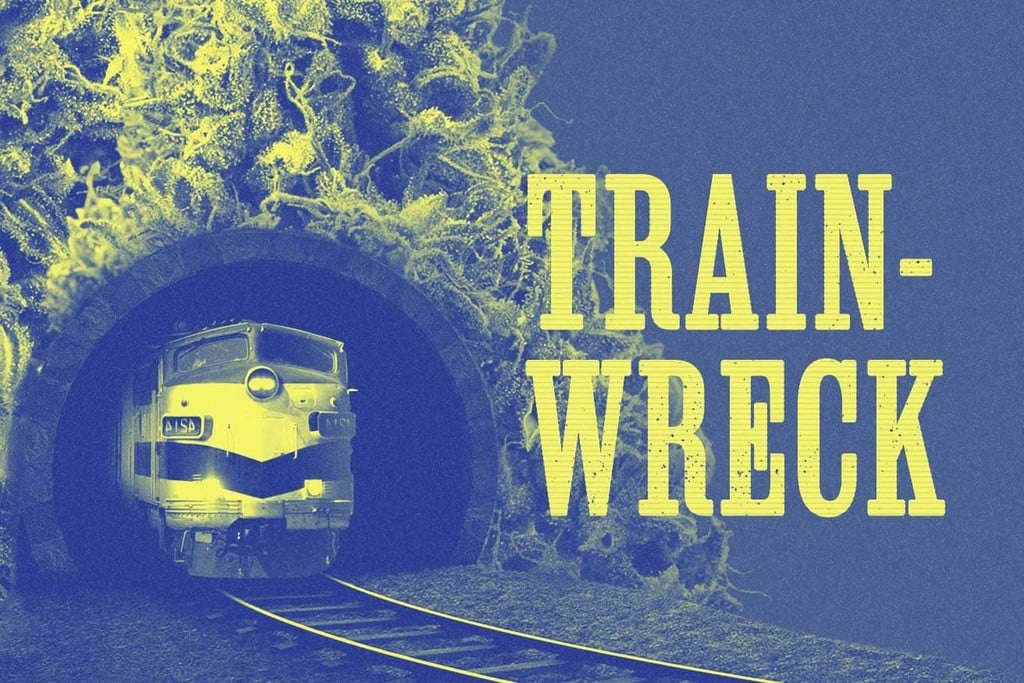.

Trainwreck Weed Strain Review
Trainwreck belongs to a generation of OG cannabis strains. Unlike the many modern hybrids enjoying the limelight, this sativa superstar has stimulated minds and taste buds alike for decades. But where exactly did this progeny of legendary landraces come from? Below, you're going to become acquainted with Trainwreck—all aboard!
Are you a fan of stimulating effects? Perhaps you’re fond of earthy and fruity terpenes? What about compact morphology? If any of these tickle your fancy, then you’ll get on just fine with Trainwreck. Keep reading to learn all about this world-famous.
Contents:
Why Trainwreck Became So Popular
Trainwreck has become a popular sativa-dominant hybrid across the world. Despite its success, it has a story of humble beginnings on the west coast of the United States. In the same vein as most legendary cultivars, this strain originates from the breeding hotspot of California.
The exact history of Trainwreck remains somewhat blurred. It’s thought that the strain emerged from the Emerald Triangle in Humboldt at the hands of two brothers passionate about breeding weed. Some speculate that a train derailed near the original breeding site, causing the duo to have to quickly get rid of the bulk of their crop.


However, although captivating, this story remains an unsubstantiated legend. Other smokers believe the name of this strain describes the high—an energising experience that comes on thick, fast, and furiously. Reports date the origins of Trainwreck to some point during the 1970s, and the best estimates label its genetic origins to Thai, Mexican, and Afghani landraces.
Unlike most popular weed strains, Trainwreck has no prestigious awards or cups tied to its name. Instead, this lively sativa gained traction the old-fashioned way—grassroots awareness. Its genetics moved from grow room to grow room and smoking spot to smoking spot until they breached America’s borders and made their way across the world.
The Effects of Trainwreck
Trainwreck weed autumns firmly onto the stimulating and energising side of the effects spectrum. This successor of legendary sativa landraces possesses a phytochemical cocktail that brings the mind to life, arousing the senses. Not dissimilar to the effects of a strong cup of coffee, puffing on these buds will immediately motivate you to get things done.
It might surprise some users to learn that Trainwreck features a THC content of just 17%. Keep in mind, though, that she is a daughter of the 1970s. Despite this moderate number, her supply of the psychoactive cannabinoid THC synergises potently with energising terpenes. This results in a clear-headed and energetic high that enables smokers to feel inspired and productive without getting distracted by excessively intoxicating effects.
Away from work and creative projects, Trainwreck also goes down great at social gatherings, parties, and raves. She’ll keep your mind turned on and your tongue sharp. Not to mention, everything seems slightly funnier after taking a hit or two.
Trainwreck
|
|
Mexican x Thai x Afghan |
|
|
550 - 600 gr/m2 |
|
|
100 - 150 cm |
|
|
9 - 10 weeks |
|
|
THC: 19% |
|
|
Sativa 90% Indica 10% |
|
|
650 - 700 gr/plant |
|
|
150 - 200 cm |
|
|
Late October |
|
|
Creative, Euphoric, Uplifting |
Trainwreck: A Look At Her Terpenes
Trainwreck’s THC levels certainly form the core of her effects. However, her terpenes play a fundamental role when it comes to her high. Furthermore, these volatile aromatic compounds also underpin her pleasant aromas and tastes. So, let’s take a closer look at the set of compounds that add so much to the Trainwreck experience. The most abundant terpenes in this cultivar include:
- Terpinolene: You don’t often encounter terpinolene as one of the most dominant secondary metabolites in a cannabis strain. However, Trainwreck produces boatloads of the stuff. This terpene also shows up in several other plants, including rosemary, oregano, tea tree, and pine trees. Overall, it adds a relaxing and soothing effect to the Trainwreck experience.
- Myrcene: This fruity phytochemical plays an important role when smoking Trainwreck bud. Myrcene has gained a reputation as a stoning and relaxing terpene. This compound also shows up in hops, cardamom, mangoes, and lemongrass, and provides fruity and earthy scents to select cannabis strains. Overall, myrcene helps to balance out the effects of the Trainwreck marijuana strain and adds an element of relaxation to the mix.
- Pinene: As its name suggests, this molecule shows up in great concentrations in pine trees. Every time you catch of whiff of that piney scent when strolling through coniferous woodland, you’re inhaling pinene. Research suggests that this terpene helps to elevate the mood, clear the mind, and reduce the short-term memory impairment induced by THC.


Aroma and Flavour of Trainwreck
Now you’re aware of the effects of each of the dominant terpenes found in Trainwreck weed, what sensory pleasures do they bring to the table? Well, these aromatic compounds converge to create aromas and flavours of citrus, earth, sour, and spice. These tastes are apparent no matter how you consume this strain. In fact, you’ll notice them when hitting pipes, blunts, and bongs. However, you’ll get a true taste of Trainwreck when vaping these buds at low temperatures.
You can also harness Trainwreck’s terpenes when crafting edibles in the kitchen. These flowers make a particularly good choice when baking cakes and brownies or whipping up a batch of gummies, thanks to their moderate THC content and distinct flavour.
_1.jpg)
Growing Trainwreck and Cultivation Difficulties
Trainwreck bestows a stimulating high with a side of earthy terpenes. But how does this sativa-dominant hybrid perform in the grow room or garden?
Let’s start by analysing how she gets on indoors. In this setting, she grows to a medium height, making her suitable for small spaces and scenarios where stealth is of the utmost importance. Raise plants under strong lights, and you can push yields up to 800g/m², although most growers typically pull in around 500g/m². However, to prevent her canopy from becoming too dense, which can increase the risk of mould and poor bud formation, apply low-stress training (LST) and topping early on in the vegetative phase.
Trainwreck also maintains a medium height outdoors. She does well in most climates, but to avoid the likes of mildew and botrytis, consider growing your plants in the shelter of a greenhouse or polytunnel if possible. The main-lining technique will also help to keep air moving through her dense canopies. Expect to harvest, trim, and dry your flowers after a flowering period of nine weeks during early October.
RQS Strains Inspired by Trainwreck
Here at Royal Queen Seeds, our breeders took an instant liking to Trainwreck. To pay homage to this classic sativa, they decided to tinker around with one of her offspring to create a new source of stimulating psychoactivity. By recruiting Pineapple Express (a direct descendant of Trainwreck) and crossing her with the legendary OG Kush, they created Pineapple Kush. This hard-hitting hybrid produces a relaxing high that very often triggers bouts of the giggles. Delicious tastes of diesel, fruit, pepper, and pineapple make her an instant hit among terpene enthusiasts. Grow this strain indoors and you’ll harvest up to 550g/m². Outdoors, she’ll offer a return of 500–550g/plant when grown in a sunny spot.
Pineapple Kush
|
|
Pineapple x O.G. Kush |
|
|
500 - 550 gr/m2 |
|
|
70 - 120 cm |
|
|
8 - 9 weeks |
|
|
THC: 18% |
|
|
Sativa 20% Indica 80% |
|
|
500 - 550 gr/plant |
|
|
120 - 180 cm |
|
|
Late September |
|
|
Calming, Laughter |
Trainwreck: A Lively and Productive Sativa
We don’t have an extensive history of Trainwreck, but we do know she stems from prestigious Cali roots. And, although she lacks notoriety on the competition circuit, this sativa-dominant hybrid has spread across the world organically. Growers started to autumn in love with her energising high and earthy terps decades ago, and she’s still winning over dedicated cultivators to this day. With great yields, stimulating effects, and scrumptious tastes, it’s not hard to see why.











































